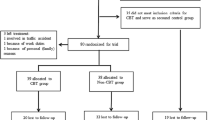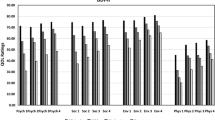Abstract
Introduction
The primary aim of this study was to examine the role of patient characteristics in predicting response to treatment in a sample of HIV-positive patients receiving 12 weekly sessions of a CBT-based pain management protocol.
Method
A pre/post test single group design was used. Pain-related functioning was assessed at baseline and 12 weeks post-treatment using the Pain Outcomes Questionnaire-VA.
Data analysis and Results
Multivariate regression analysis showed that higher baseline levels of pain-related anxiety were related to greater improvement in pain-related functioning at post-treatment, and non-Caucasian participants reported a greater response to treatment when compared to Caucasian participants. Attendance to CBT treatment sessions focused on progressive muscle relaxation and cognitive reconceptualization of pain were also related to treatment outcome.
Conclusion
Non-Caucasian patients reporting higher levels of pain-related anxiety may respond particularly well to treatment. Treatment sessions focused on progressive muscle relaxation and cognitive reconceptualization of pain may be particularly helpful.
Similar content being viewed by others
References
Asmundson, G. J. G., Norton, G. R., & Allerdings, M. D. (1997). Fear and avoidance in dysfunctional chronic back pain patients. Pain, 69, 231–236. doi:10.1016/S0304-3959(96)03288-5.
Baird, C. L., & Sands, L. (2004). A pilot study of the effectiveness of guided imagery with progressive muscle relaxation to reduce chronic pain and mobility difficulties of osteoarthritis. Pain Management Nursing, 5(3), 97–104. doi:10.1016/j.pmn.2004.01.003.
Beckett, M., Burnam, A., Collins, R. L., Kanouse, D. E., & Beckman, R. (2003). Substance use and high-risk sex among people with HIV: A comparison across exposure groups. AIDS and Behavior, 7(2), 209–219. doi:10.1023/A:1023906610710.
Breitbart, W., McDonald, M. V., Rosenfeld, B., Passik, S. D., Hewitt, D., Thaler, H., et al. (1996). Pain in ambulatory AIDS patients. I: Pain characteristics and medical correlates. Pain, 68(2–3), 315–321. doi:10.1016/S0304-3959(96)03215-0.
Buenaver, L. F., McGuire, L., & Haythornthwaite, J. A. (2006). Cognitive-behavioral self-help for chronic pain. Journal of Clinical Psychology, 62(11), 1389–1396. doi:10.1002/jclp.20318.
Cheung, Y. L., Molasssiotis, A., & Chang, A. (2002). The effect of progressive muscle relaxation training on anxiety and quality of life after stoma surgery in colorectal cancer patients. Psycho-Oncology, 12(3), 254–266. doi:10.1002/pon.638.
Clark, M. E., Gironda, R. J., & Young, R. W. (2003). Development and validation of the Pain Outcomes Questionnaire-VA. Journal of Rehabilitation Research and Development, 40(5), 381–396.
Evans, S., Fishman, B., Spielman, L., & Haley, A. (2003). Randomized trial of cognitive behavioral therapy versus supportive psychotherapy for HIV-related peripheral neuropathic pain. Psychosomatics, 44(1), 44–50. doi:10.1176/appi.psy.44.1.44.
Glare, P. (2001). Pain in patients with HIV infection: Issues for the new millennium. European Journal of Pain, 5(A), 43–48.
Greenburg, A. E. (2007). New approaches to tracking the HIV/AIDS epidemic in the United States. http://www.cdc.gov/hiv/resources/slides/pdf/Greenberg_Plenary.pdf. Accessed 6 September 2008.
Guo, C. J., Li, Y., Tian, S., Wang, X., Douglas, S., & Ho, W. Z. (2002). Morphine enhances HIV infection of human blood mononuclear phagocytes through modulation of beta-chemokines and CCR5 receptor. Journal of Investigative Medicine, 50(6), 435–442. doi:10.2310/6650.2002.32503.
Ho, W. Z., Guo, C. J., Yuan, C. S., Douglas, S. D., & Moss, J. (2003). Methylnaltrexone antagonizes opioid-mediated enhancement of HIV infection of human blood mononuclear phagocytes. The Journal of Pharmacology and Experimental Therapeutics, 307, 1158–1162. doi:10.1124/jpet.103.056697.
Horrell, S. C. (2008). Effectiveness of cognitive-behavioral therapy with adult ethnic minority clients: A review. Professional Psychology, Research and Practice, 39(2), 160–168. doi:10.1037/0735-7028.39.2.160.
Larue, F., Fontaine, A., & Colleau, S. (1997). Underestimation and under treatment of pain in HIV disease: Multicentre study. British Medical Journal, 314, 23–28.
Lechner, S. C., Antoni, M. H., Lydston, D., LaPerriere, A., Ishii, M., Devieux, J., et al. (2003). Cognitive-behavioral interventions improve quality of life in women with AIDS. Journal of Psychosomatic Research, 54, 253–261. doi:10.1016/S0022-3999(02)00480-4.
McCracken, L. M., & Dhingra, L. (2002). A short version of the pain anxiety symptoms scale (PASS-20): Preliminary development and validity. Pain Research & Management, 7(1), 45–50.
McCracken, L. M., & Gross, R. T. (1998). The role of pain-related anxiety reduction in the outcome of multidisciplinary treatment for chronic low back pain: Preliminary results. Journal of Occupational Rehabilitation, 8(3), 179–189. doi:10.1023/A:1021374322673.
McCracken, L. M., & Turk, D. C. (2002). Behavioral and cognitive-behavioral treatment for chronic pain: outcome, predictors of outcome, and treatment process. Spine, 27(22), 2564–2573. doi:10.1097/00007632-200211150-00033.
McCracken, L. M., Zayfert, C., & Gross, R. T. (1992). The pain anxiety symptoms scale: Development and validation of a scale to measure fear of pain. Pain, 50, 67–73. doi:10.1016/0304-3959(92)90113-P.
Nicholson, B. (2003). Responsible prescribing of opioids for the management of chronic pain. Drugs, 63(1), 17–32. doi:10.2165/00003495-200363010-00002.
Norval, D. A. (2004). Symptoms and sites of pain experienced by AIDS patients. South African Medical Journal, 94(6), 450–454.
Osman, A., Barrios, F. X., Osman, J. R., Schneekloth, R., & Troutman, J. A. (1994). The pain anxiety symptoms scale: Psychometric properties in a community sample. Journal of Behavioral Medicine, 17(5), 511–522. doi:10.1007/BF01857923.
Payne, R. (2000). Limitations of NSAIDS for pain management: Toxicity or lack of efficacy? Journal of Pain, 1(3), 14–18. doi:10.1054/jpai.2000.16611.
Roelofs, J., McCraken, L., Peters, M. L., Crombez, G., van Breukelen, G., & Vlaeyen, J. W. S. (2004). Psychometric evaluation of the Pain Anxiety Symptoms Scale (PASS) in chronic pain patients. Journal of Behavioral Medicine, 27(2), 167–183. doi:10.1023/B:JOBM.0000019850.51400.a6.
Rosenfeld, B., Breitbart, W., McDonald, M. V., Passik, S. D., Thaler, H., & Portenoy, R. K. (1996). Pain in ambulatory AIDS patients. II: Impact of pain on psychological functioning and quality of life. Pain, 68, 323–328. doi:10.1016/S0304-3959(96)03220-4.
Trafton, J. A., Sorrell, J. T., Link, P., & Israelski, D. (2006). Integrated pain management for patients with HIV receiving care in a public setting: Preliminary results. Poster presented at the XVI Annual International AIDS Conference, Toronto, CA.
Turk, D. C., & Gatchel, R. J. (Eds.). (2002). Psychological approaches to pain management: A practitioner’s handbook (2nd ed.). New York: The Guilford Press.
Turk, D. C., & Okifuji, A. (2002). Psychological factors in chronic pain: Evolution and revolution. Journal of Consulting and Clinical Psychology, 70, 678–690. doi:10.1037/0022-006X.70.3.678.
van Tulder, M. W., Ostelo, R., Vlaeyen, J. W. S., Linton, S. J., Morely, S. J., & Assendelft, W. J. J. (2000). Behavioral treatment for chronic low back pain: A systematic review within the framework of the cochrane back review group. Spine, 26(3), 270–281. doi:10.1097/00007632-200102010-00012.
Ventafridda, V., Saita, L., Ripamonti, C., & De Conno, F. (1985). WHO guidelines for the use of analgesics in cancer pain. International Journal of Tissue Reactions, 7(1), 93–96.
Verucchi, G., Calza, L., Manfredi, R., & Chiodo, F. (2004). Human immunodeficiency virus and hepatitis C virus coinfection: Epidemiology, natural history, therapeutic options and clinical management. Infection, 32(1), 33–46. doi:10.1007/s15010-004-3063-7.
Vlaeyen, J. W. S., Kole-Snijders, A. M. J., Boeren, R. G. B., & van Eek, H. (1995). Fear of movement/(re)injury in chronic low back pain and its relation to behavioral performance. Pain, 62, 363–372. doi:10.1016/0304-3959(94)00279-N.
Vlaeyen, J. W. S., & Linton, S. J. (2000). Fear-avoidance and its consequences in chronic musculoskeletal pain: A state of the art. Pain, 85, 317–332. doi:10.1016/S0304-3959(99)00242-0.
Acknowledgments
The work described in this manuscript was supported by the Health Services Research and Development Service, Department of Veterans Affairs, and by a community collaborative grant from the California HIV/AIDS Research Program (CR04-PAIRE-519).
Disclaimer
The opinions expressed are those of the authors and do not reflect the official positions of the Department of Veterans Affairs nor the California HIV/AIDS Research Program.
Author information
Authors and Affiliations
Corresponding author
Rights and permissions
About this article
Cite this article
Cucciare, M.A., Sorrell, J.T. & Trafton, J.A. Predicting response to cognitive-behavioral therapy in a sample of HIV-positive patients with chronic pain. J Behav Med 32, 340–348 (2009). https://doi.org/10.1007/s10865-009-9208-5
Received:
Accepted:
Published:
Issue Date:
DOI: https://doi.org/10.1007/s10865-009-9208-5




